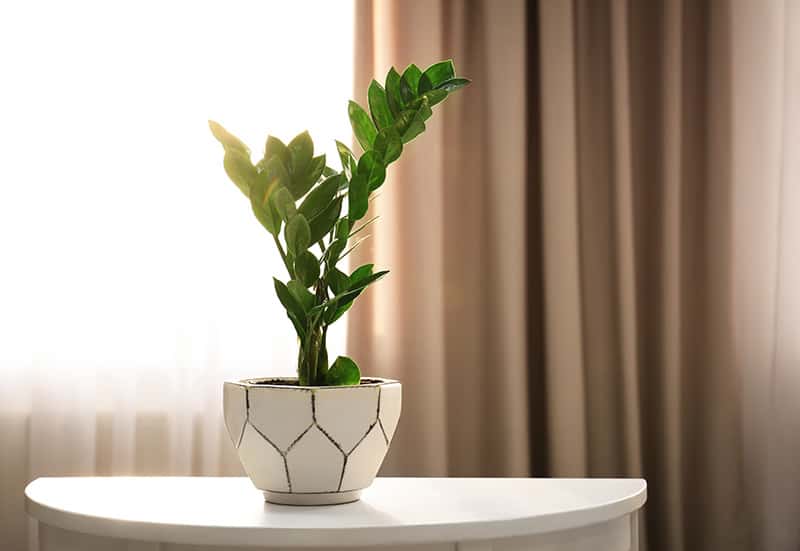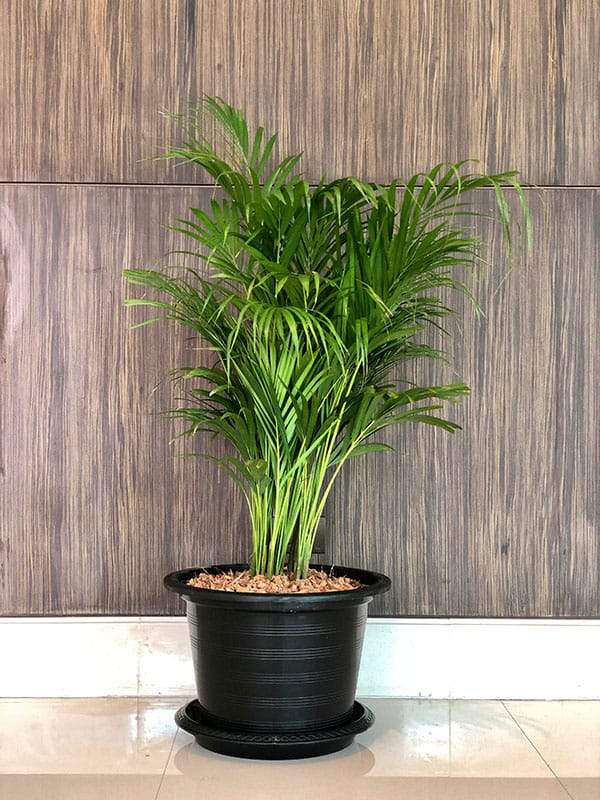- Home >
- Dieffenbachia (Dumb Cane) Plants
Dieffenbachia (Dumb Cane Plant) for Sale - Buying & Growing Guide
Planting and Care
Planting instructions
The Dieffenbachia Plant prefers filtered light, especially in the spring and summer when new growth is vulnerable to being burned by direct exposure to the sun. Place the plant in indirect or dappled light shielded with a sheer curtain. The plant can tolerate low light, though its growth may slow or stop. Rotate it on a regular basis to make sure that it grows evenly.
Keep your Dieffenbachia in a warm spot away from drafts, with temperatures ranging between 60 and 80 degrees Fahrenheit. Yellow leaves and leaf drop are an indication of exposure to cold.
Grow Dieffenbachia in soil with good drainage and plenty of peat content. Dieffenbachia that receives proper light, well aerated soil, and the right amount of water will grow quickly, especially if given plenty of room. To encourage a Dieffenbachia to grow to a height of five feet or taller, plant it in a large container. A smaller pot will produce a smaller, more compact plant.
Watering and nutrients
Dieffenbachias like to be kept moist but not waterlogged. If you water it to the point where water drains through its container’s holes once or twice a week, your plant should thrive. Overwatering causes yellow, droopy leaves. Double check that you’re watering appropriately by ensuring that the top layer of soil is dry before watering. The frequency that the plant needs water will depend on its location, temperature, and humidity.
March to October is the growing season for Dieffenbachia. During those months the plant will require more water, as well as regular feeding with liquid plant food (10-10-10) every other week during the growing season. Discontinue fertilizer applications during the winter months.
Light
This plant does well in a variety of lighting situations, from light shade to bright indirect light. The leaves will be at their most vibrant when the plant receives a good amount of bright, indirect light, though any direct light should be avoided as this can burn the leaves or cause the foliage coloring to look bleached or faded. The Dieffenbachia would ideally like to be in bright light that is filtered through sheer fabric, or another type of window covering that will allow light to pass through it. Although Dieffenbachias prefer bright light, they will do just fine in moderate light or even partially shaded environments.
Though a shaded area isn’t recommended for this plant, if it finds itself in a dark corner, it will manage to stay alive and maintain a healthy appearance, but it will stop growing. Given the plant’s adaptability to a variety of lighting conditions, it makes for a good easy-care houseplant in most homes and offices. Dieffenbachias are also a good choice to brighten up dull commercial spaces as they can survive entirely on artificial light.
Propagation
Dieffenbachias are easy to propagate. All you need is a clean, sharp knife or razor and a container with well-draining potting soil for sticking the cuttings. African violets potting mix is a good choice, or you can mix two parts pre-moistened peat moss with two parts perlite.
There are three different methods for propagating Dieffenbachia from cuttings. Propagate Dieffenbachia in the spring, prior to the start of the growing season.
- Top shoots. For plants that are top heavy and leggy. Cut off a bare stem and retain the top section of the stem. Dip the cut end into rooting hormone powder and stick it in prepared potting soil. After a few weeks, tug gently on the cutting to check for root growth. Once roots form, plant the shoot into the prepared soil.
- Suckers. Suckers are the new growth shoots that appear at the base of a plant. Remove suckers from the parent plant and root in the same way as the top shoots.
- Stem shoots. Stem shoots cuttings are propagated from an area of a stem that has several leaf buds. By cutting off a stem like this and placing it on its side, halfway buried in the potting soil with the “eyes” or leaf buds pointing up, the plant will root in a few weeks. You can speed up the process by covering the plant tray with a plastic bag which will provide constant moisture.
Note: Most cuttings from Dieffenbachia can also be rooted in a container of water. When roots form, pot-up the cutting in a container with soil.
Pruning
Dieffenbachia left unpruned will eventually get leggy and less attractive. Occasional pruning will keep your plant looking healthy and full. Use gardening gloves, when working with Dieffenbachia to protect skin. Cutting or ‘wounding’ Dieffenbachia produces a sap that causes itching skin, burning eyes, and swelling of the mouth and throat. To cut stems or ‘canes,’ use a sharp, clean knife and cut at a 45-degree angle. When cutting back a Dieffenbachia Plant, do not remove more than one third of the plant stems. Cuts should always be made about a quarter inch above a new growth node or point, and about six inches above the soil.
Pests, diseases, and animals
Dieffenbachia is a hardy plant, but it can still be attacked by typical houseplant pests like spider mites, aphids, and scale. Though you can often wipe away these pests with a swab soaked in rubbing alcohol, you should treat a more widespread infestation with a systemic pesticide.
Dieffenbachia is vulnerable to several different rotting diseases caused by overwatering. These include Erwinia blight, Fusarium stem rot, Phytophthora stem, root and leaf spot, and Anthracnose leaf spot. Careful watering is the best way to avoid these diseases. You should also sterilize your cutting tools before propagation or pruning to avoid transferring bacteria from one plant to another.
Finally, it is essential that you keep pets away from your Dieffenbachia. The same plant toxins that will cause humans discomfort are extremely toxic to dogs and cats.
Humidity
The Dieffenbachia likes high humidity and will thrive in humid conditions. Because of this, the plant does especially well when kept in kitchens and bathrooms that tend to be quite humid. As well as keeping your plant happy, providing high humidity is also an easy way to deter some pests. Spider mites tend to latch on to houseplants when the air is dry, so maintaining a humid environment should help to prevent you from having to deal with this problem.
Most homes are not naturally humid places, but you can easily increase the humidity for your plants in various ways. Spraying plants frequently with a light mist of water will increase the humidity, and this also has the added benefit of keeping dust from settling on the leaves. Another way to increase humidity is the use of a rock tray. Sit your Dieffenbachia Plant on a tray that is covered in rocks or pebbles, and then, cover the pebbles with water. As the water evaporates, the air around the plant will become more humid. Humidity will also be increased by grouping plants together. You could also use an electric humidifier to battle dry air.
Although the Dieffenbachia Plant prefers humid conditions, it usually does just fine in average humidity found in homes. Keep an eye on the Dieffenbachia and take note if your plant starts to react badly in a low humidity environment, as you may need to address the issue. Also, be on the lookout for spider mites on your plant in low humidity.
Repotting
Dieffenbachia Plants should be repotted with caution. If you give your plant more space to grow its roots, then it will also begin to require more space outside of the pot. Many varieties of Dieffenbachia can grow to ceiling-height quite rapidly, so if you would prefer to keep your plant compact, then you will need to keep it in a restrictive pot. If you do go ahead and repot your Dieffenbachia, wear protective gloves with long sleeves, as the sap contained in both the leaves and the stem is a poisonous irritant that can cause pain and discomfort if it comes into contact with skin. If you do get the sap onto your skin, wash thoroughly and avoid touching your mouth or eyes.
FAQs
What should I do if leaves are dropping and developing dry spots?
Dropping leaves may be an indication of underwatering or inconsistent watering. Give your plant about an inch of water per week and ensure that it is draining well. If that doesn’t solve the problem, it may not be getting enough light.
Is it okay to remove my plant’s flowers?
The Dieffenbachia Seguine’s beauty lies in its leaves rather than its flowers, and many people find the flowers a distraction. If you remove them using a sharp, clean set of shears, it will encourage the growth of more leaves.


